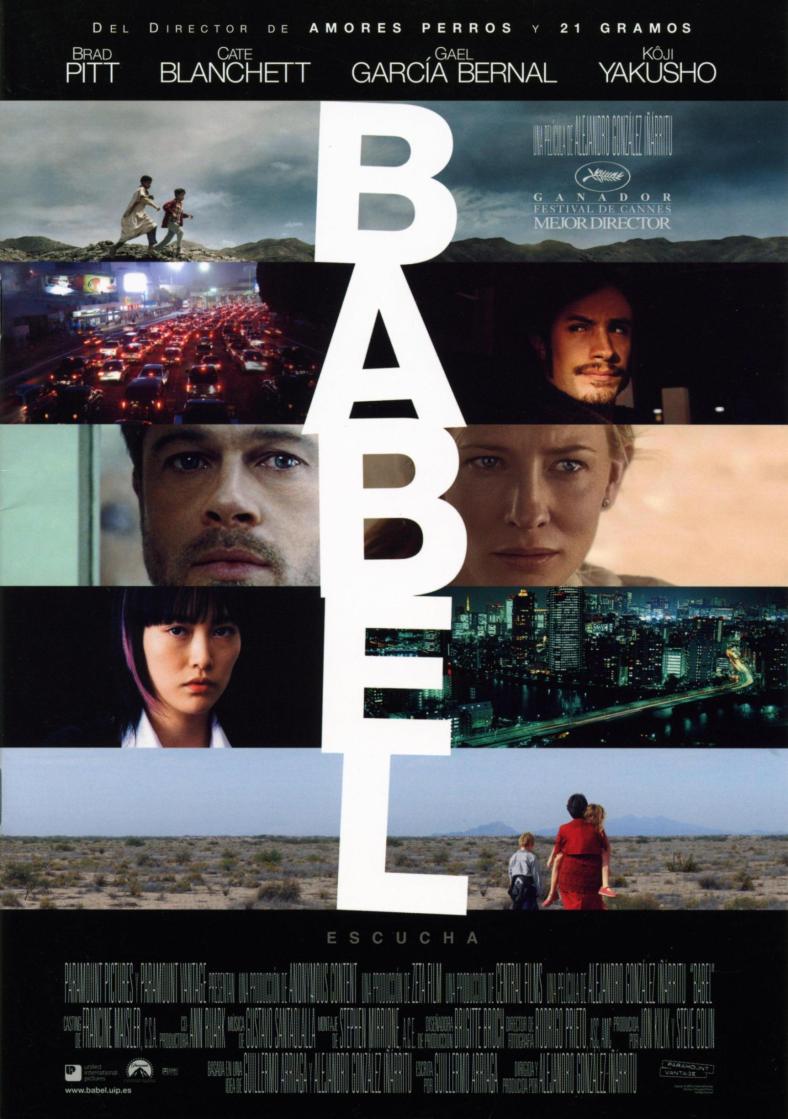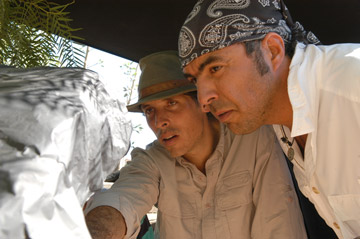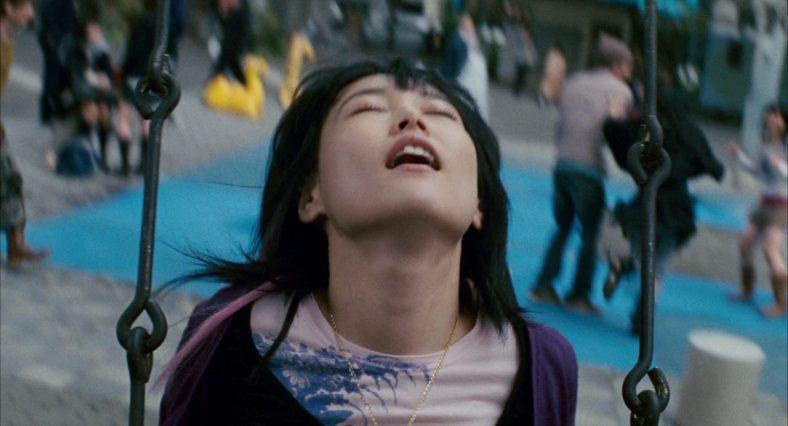Chieko, a deaf-mute Japanese teenage girl, is hanging around with some friends in the afternoon in Tokyo. A troubled girl, traumatized by the suicide of her mother, Chieko has difficulty connecting with the world around her (beyond her being deaf-mute). She is rebellious towards her father and doesn’t seem to connect so well with boys her age.
Except, on this afternoon, she seems to have found a cool group of youngsters who appreciate her. They hang around in a playground together and one of the boys convinces Chieko to take some drugs. After a short while the drugs kick in and the group of kids start playing around the playground. Slowly the noises of the city fade away and the world outside their little group seems to blur. Chieko climbs onto a swing and drifts away in her own, momentary, happiness.
Babel & the Death Trilogy
I say ‘momentary’ as Babel (2006) is not a film where people are permitted to feel happiness for too long. On the whole Babel is a sad and emotional thesis on the suffering we endure because of our failure to communicate. The film, the third in the loosely related ‘death trilogy’ of director Alejandro González Iñárritu, tells four separate, but related stories about communication and mis-communication. In this approach its a continuation of the previous films in the trilogy Amores Perros (2000) & 21 Grams (2003), both of whom tell these separate-but-related-stories, also filled with sadness and suffering.
Difficult as these movies are to watch, they offer some of the best drama I’ve seen these past two decades. They combine raw, natural cinematography with incredible performances and beautiful music to create a very lyrical and moving style that pushes its dramatic stories forward without feeling melodramatic (most of the times).
Babel is probably the one with the most cross-over popularity, in that it had the largest audience and media-coverage (no doubt helped by the star-power of Brad Pitt), and though I’m not sure it’s the best of the trilogy, it is the one I’ve watched most often and the one where I feel the connected-stories approach really delivers something greater than the sum of its parts.
Rogrigo Prieto & the naturalness of film
All of these three films have been shot by the cinematographer Rodrigo Prieto. Interestingly, Prieto came from Mexico City and knew Emanuel Lubezki, the cinematographer of The Tree of Life among others. And though Lubezki’s style is different from Prieto, I see the same kind of naturalness in both of their work. Not ‘realistic’, but ‘organic’ as Prieto says in an interview. ‘It’s something I’ve always tried to incorporate in what I’m doing – not necessarily realism but [being] organic to the material…’
As I’m writing these posts about cinematography that concept has come up several times in my analyses, and the more I think about it, the more it appears to be a unifying aspect in all of my favorite work, that naturalness Prieto talks about. Because that is also what appeals to me in his work in Babel.
I referred to this in my posts for The Tree of Life, Lost in Translation and The Insider, all of which had different cinematographers, but all shared that ‘naturalness’, with maybe The Insider being slightly more raw and less dreamlike than the others.
That naturalness might be traced back to the literal technical aspects of those films (i.e. using film instead of digital or using lots of natural available light instead of lighting-rigs) as well as artistic choices in composition and mise-en-scene.
Three styles
In Babel, Prieto succeeded in stylistically separating the three stories without destroying the visual unity of the entire film. He used different film-stocks and cameras to separate the stories in their texture and color (grainier, less saturated in Morocco vs. high-contrast in Mexico and more dreamlike magenta tones in Japan) as well as simply decorating the scenes with the appropriate colors.Separate as these styles may be, in general the film persistently has that naturalness in its look and I love that about Babel.
Still, my favorite part of the film is the storyline in Japan, the story of the deaf-mute girl Chieko who desperately wants to connect with the outside world. It’s the most emotionally resonant story of the three and the one which feels least like ‘you know something bad is gonna happen and you’re just wating for it’ (something I dislike about especially the Mexican story, but its prevalent in other Iñárritu films, always something bad has to happen to the characters).
The cinematography in this part is perhaps the most stand-out feature of the whole movie for me. Prieto shot it with anamorphic lenses which help a lot in dreaming up the footage (anamorphics create that distinct widescreen look with stretched bokeh and slight vertical distortion) and he also really narrowed the depth of field, making you fully a part of Chieko’s personal bubble.
And to me, in a movie about mis-communication that visual, of being part of Chieko’s bubble, is the most powerful way of expression that emotion. In other parts of the movie the theme of mis-communication produced frustration with me where it made me wanna stand up and shout some sense in the ears of the characters, which might be appropriate, but it’s not necessarily a pleasant experience to sit through and it can also feel a bit manipulative.
The magic of Chieko’s story is that it’s a beautiful story to sit through yet it also makes you sad. You are entertained, but also alerted to the issues of bad- or non-communication. You understand her suffering, but you are glad to have understood it.
One Shot
Which leads me, at last, to my single, One Shot. And its this one:
It’s Chieko, sitting on a swing, eyes closed, high on drugs, numb to her outside world and for the first time seeming happy. The camera is with her on the swing and stays there for almost 20 seconds, before you cut to a wide shot of her swinging.
The shot works through its first-person movement as you float along with Chieko. But then it is also complemented by the blurry backgrounds which push Chieko to the foreground and really connect us to her. I also love the way Chieko’s pink hairs, pink shirt and purple sweater match up and complement her skin-tone tying the whole shot together visually.
But mostly I recall the shot so well because its such a powerfully simple visual. Its sitting on a swing with your eyes closed while the world drifts to the background. It connects to my own experiences as a child, making it relatable, while also conveying that strong emotion, that Chieko is isolated and separate from her surroundings.
It’s beauty and sadness folded into one and utterly captivating as a cinematographic image.



One thought on “Babel (2006)”